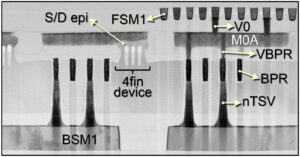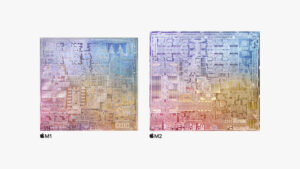
EDACafe Editorial Roberto Frazzoli
Roberto Frazzoli is a contributing editor to EDACafe. His interests as a technology journalist focus on the semiconductor ecosystem in all its aspects. Roberto started covering electronics in 1987. His weekly contribution to EDACafe started in early 2019. Backside power delivery; GaN-on-Si for 5G; Apple’s M2; new Fraunhofer centerJune 16th, 2022 by Roberto Frazzoli
Geopolitical issues keep making news: a team of U.S. investors, scientists, operators, and national security experts has founded America’s Frontier Fund (AFF), described as “the nation’s first non-profit strategic investment fund focused on building and scaling breakthrough deep-tech companies and platforms for the national interest.”. Led by CEO and co-founder Gilman Louie, AFF intends to counter “authoritarian nations” that “are committed to out-spending and out-innovating the U.S. to gain military and economic superiority.” The fund’s initial areas of focus will include microelectronics, artificial intelligence, new materials, quantum sciences, next generation networks (5G/6G), advanced manufacturing, and synthetic biology. Let’s now move to other news updates, this week with a significant presence of European research centers. Imec demonstrates backside power delivery with buried power rails Belgian research institute Imec has demonstrated a routing scheme for logic ICs with backside power delivery enabled through nano-through-silicon-vias (nTSVs) landing on buried power rails (BPRs). The BPRs connect to scaled FinFET devices whose performance was not impacted by backside wafer processing. The novel routing scheme with decoupled power and signal wiring acts as a scaling booster for future logic technologies (2nm and beyond), as the nTSVs land on BPRs with tight overlay control and are implemented at a tight pitch of 200nm without consuming any area of the standard cell. The solution also offers a system performance benefit by improving the power delivery, as it reduced IR voltage drop. Additionally, Imec demonstrated a performance boost by implementing a 2.5D MIMCAP (metal-insulator-metal capacitor) in the backside serving as a decoupling capacitor. Backside power delivery – using the back side of the wafer to route power lines, in order to alleviate routing congestion on the front side and reduce IR voltage drop – can be implemented in different ways; Imec believes that combining it with buried power rails is the most promising implementation scheme.  TEM image showing scaled FinFET devices connected to the wafer’s backside (through nTSVs and BPR) and frontside (through BPR, VBPR and MOA). Copyright: Imec
Renesas invests in Arduino Renesas has announced a $10 million investment in Arduino’s new round of Series B funding. With this partnership, Renesas aims to make its products available for Arduino’s technology platforms used by a community of thirty million developers worldwide. The funding will provide Arduino with access to Renesas’ technology portfolio, including MCUs/MPUs, analog, power, and connectivity products. Arduino has recently unveiled plans to expand its portfolio of hardware, software, connectivity and developer tools for professionals and into the enterprise, broadening its offering beyond makers and students. Startup promotes GaN-on-Si for 5G power amplifiers Spun off from MIT in 2012 as Cambridge Electronics, a startup now renamed Finwave Semiconductor has developed a new technology aimed at overcoming the power and linearity limitations of RF-SOI and CMOS currently used to build millimeter wave power amplifiers for 5G networks. Called 3DGaN, Finwave’s new technology is a GaN-on-silicon process using FinFET GaN transistors and fabricated with standard 8” silicon CMOS tools. According to the company – just emerged from stealth – 3DGaN technology significantly improves linearity, output power and efficiency in 5G mmWave systems while greatly reducing costs for carriers. New M2 Apple processor raises the bar for performance-per-watt On occasion of its recent Developers Conference (WWDC22), Apple announced its new M2 processor, the second generation of Apple silicon designed specifically for the Mac. A 20-billion transistor system-on-chip built using 5-nanometer technology, M2 boasts several improvements over M1: an 18 percent faster CPU, a 35 percent more powerful GPU, and a 40 percent faster neural engine. It also delivers 50 percent more memory bandwidth compared to M1, and up to 24GB of fast unified memory. Performance-per-watt is the key metrics that Apple used to compare the CPU in M2 with Intel’s PC laptop chips: according to the Cupertino giant, compared with Intel Core i7-1255U, the CPU in M2 provides nearly twice the performance at the same power level. And M2 delivers the peak performance of this Intel chip while using just a quarter of the power. Also, based on Apple’s tests, M2 provides nearly 90 percent of the peak performance of the Intel Core i7-1260P chip while using just one-fourth the power. As noted by The Register, however, Apple admitted that – in absolute terms – the Intel Core i7-1260P CPU achieves a higher CPU peak performance. New Fraunhofer research center in Dresden, Germany The German city of Dresden, heart of the so-called “Silicon Saxony”, will host the new “Center for Advanced CMOS & Heterointegration Saxony”, which is being built at one of Fraunhofer IPMS’ sites in a new 4000 square meter clean room. Powered by two Fraunhofer institutes – Fraunhofer IPMS and Fraunhofer IZM-ASSID – the center will offer the complete value chain in 300 mm microelectronics. Acquisitions Michigan-based Altair, a vendor of software for computational science and artificial intelligence, has acquired Concept Engineering (Freiburg, Germany), a provider of electronic system visualization software. Concept Engineering’s solutions include automatic schematic generation tools, electronic circuit and wire harness visualization platforms that provide on-the-fly visual rendering, and electronic design debug solutions. These solutions are available as standalone products and are also integrated into more than forty EDA and CAD tools. Concept Engineering’s software will be integrated into Altair’s Electronic System Design suite. France-based Allegro DVT, a provider of video codec compliance test suites and semiconductor video IPs, has completed the acquisition of Labwise, a Finnish company that specializes in digital TV device testing services to TV broadcasters, network operators and device manufacturers. Upcoming events Leti Innovation Days, an event organized by French research institute CEA-Leti, is scheduled for June 21-23, in Grenoble, France. PowerUP virtual conference and exhibition will be running online from June 28 to 30. ITF USA, the U.S. edition of Imec Technology Forum, will take place in San Francisco on July 11, a few blocks away from the DAC and Semicon West. For more events, see the EDACafe event calendar. |
|
|
|||||
|
|
|||||
|
|||||







